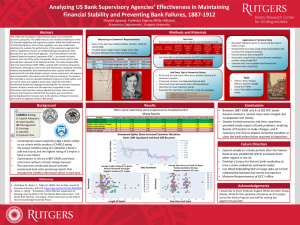Agrawal, Shivank: Analyzing US Bank Supervisory Agencies’ Effectiveness in Maintaining Financial Stability and Preventing Bank Failures, 1887-1912

Title: Analyzing US Bank Supervisory Agencies’ Effectiveness in Maintaining Financial Stability and Preventing Bank Failures, 1887-1912
Name: Shivank Agrawal
Major: Computer Science and Business Analytics
School affiliation: School of Arts and Sciences and Business School
Programs: Aresty Summer Science Program
Other contributors: Eugene White and Allen Zhang
Abstract: The safety and soundness of the financial system are essential for economic prosperity. The 2008 financial crisis revealed weaknesses in the US financial regulatory and supervisory system. While the Dodd-Frank Act of 2010 attempted to reform bank regulation, very few studies have attempted to evaluate the performance of the supervisory agencies that enforce regulations because of confidentiality governing banks’ data. Records from two of the three agencies – the Federal Reserve and the Federal Deposit Insurance Corporation (FDIC) – are closed, but early archives from the Office of the Comptroller of the Currency (OCC) have recently been released to the National Archive. This study analyzes New York City examinations (1887-1908), a period with numerous bank panics and failures. Although a century old, bank examination standards resemble modern-day standards. Bank examinations were surprise audits that produced both hard data (balance sheets, income statements, and expense and compensation information) and soft data (commentary). For analysis, the hard data is used to calculate traditional measures of bank safety, such as reserve ratios and capital to asset ratios, while the soft data is transformed by Natural Language Processing (NLP) to measure examiners’ opinion. Analysis reveals how the examiners responded to new information and how their actions affected the banks. Data on bank closures and recoveries indicate that the system was successful in protecting depositors because even in the absence of deposit insurance there were no depositor losses in this period.